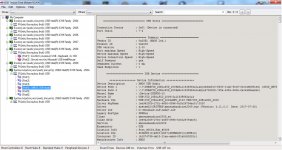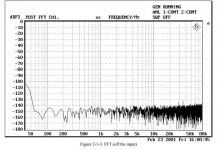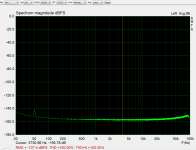Thanks a lot! It must be something else... I remember I had the same issue with UMC202. Also did another member: Behringer UMC 202HD for measurements Do you have any similar experience?
I do not understand why that link - the REW spectra show 192kHz capture.
How does your problem with 48kHz max speed appear? How did you learn that no faster capture is available on your system?
How does your problem with 48kHz max speed appear? How did you learn that no faster capture is available on your system?
Perhaps is an expression mistake from my side. If you look at #28, I can also capture at 192k. But it doesn't provide much more than 48k other than a rough picture of unusual spikes happening at ultrasonic spectrum. Not based on any expertise, I simply thought that it would be possible to take an even noise floor up to Nyquist frequency. Apologies for my ignorance.
I do not have that device but your performance chart at 192kHz is not unrealistic, IMO. There are no measurements above 20kHz in the CS4272 codec datasheet https://d3uzseaevmutz1.cloudfront.net/pubs/proDatasheet/CS4272_F1.pdf . Behringer has not released any higher frequency measurements either.
Obviously I was on the wrong track once again. But the discussion was helpful. I understood that the rising noise level at high sampling rates is related to the digital converter. Here is an example with another soundcard: ASUS Xonar Essence ST/STX soundcards Measurements | Stereophile.com Read down at fig15. So, one query solved.
Yeah, good performance at higher frequencies is not a simple and cheap task. Most vendors do not publish any data, for the chips as well as for the end products. I believe for a reason 🙂
Rising noisefllor is tipical for CS4272, but not all ADC/DAC's are the same.
Budget DAC Review: behringer UMC204HD | Page 3 | Audio Science Review (ASR) Forum
Budget DAC Review: behringer UMC204HD | Page 3 | Audio Science Review (ASR) Forum
Most audio ADC's do have that noise shaping rise in the band above 20 KHz. Only the recently discontinued AK5394A is low through to around 80 KHz or more that I know of (see below). The measurements of the Asus card suggest limited bandwidth regardless of sample rate.
Attachments
I've been working on the 50Hz and harmonics noise. It is clearly related to the opa1656 section. The opa1632 alone works very good. As said, the incandescent lamps are not responsible for this problem. I tried to lower the input potensiometer to 20k and even 10k with no effect. Installing bias resistors from opa1656 inputs to gnd ahead of anything else didn't help either. Same for elevating the input at Vcom as with opa1632. I run out of ideas... One last thought is that the opa1656 maybe too delicate for this job... What would make for an ideal opamp for this application?
I would recommend the followings:
1) Try to make a better shielding for the input circuit or the whole unit. Using something made of steel would be ideal.
2) Sometimes the shielding of the cable itself could pickup some noise. You could try different cables to see if there is a problem there.
3) If the noise insists then I think it is due to the grounding of the circuit (on the PCB or the grounding connecting cables)
1) Try to make a better shielding for the input circuit or the whole unit. Using something made of steel would be ideal.
2) Sometimes the shielding of the cable itself could pickup some noise. You could try different cables to see if there is a problem there.
3) If the noise insists then I think it is due to the grounding of the circuit (on the PCB or the grounding connecting cables)
The problem insists even if no cable is used at all. It can be done by using the right input channel and the mono/dual switch. As for the grounding scheme in general, not much can be done but it was working fine before the addition of the opa1656. Which is a necessary stage because the opa1632 alone won't work with the front end. Also, I tried to shield the potensiometer with copper foil. I can try to wrap the whole structure. I'll see if I can do it with steel.
Agree. It is clean 50Hz, no harmonics so no ground loop from the power supply. Must be radiation or induction from mains/transformer.
@MagicBus, what is your power supply requirement? I may have a solution for you to get rid of that 50Hz if you are interested.
Jan
@MagicBus, what is your power supply requirement? I may have a solution for you to get rid of that 50Hz if you are interested.
Jan
It needs +/-15V at the regulators input. I haven't measured the power consumption but based on datasheets, it is around 155mA at idle. The output drivers may increase that close to 200mA for a heavy load.
OK, I can send you one of my Silentswitchers to verify that the mains spur is gone. It delivers +/-15V from a USB port, a USB charger or a Powerbank for total mains isolation. It also has a 5V output you can use.
You like it, you pay, if not send it back, no risk ;-)
Jan
You like it, you pay, if not send it back, no risk ;-)
Jan
- Home
- Design & Build
- Equipment & Tools
- DIY soundcard intended for measuring amplifiers


